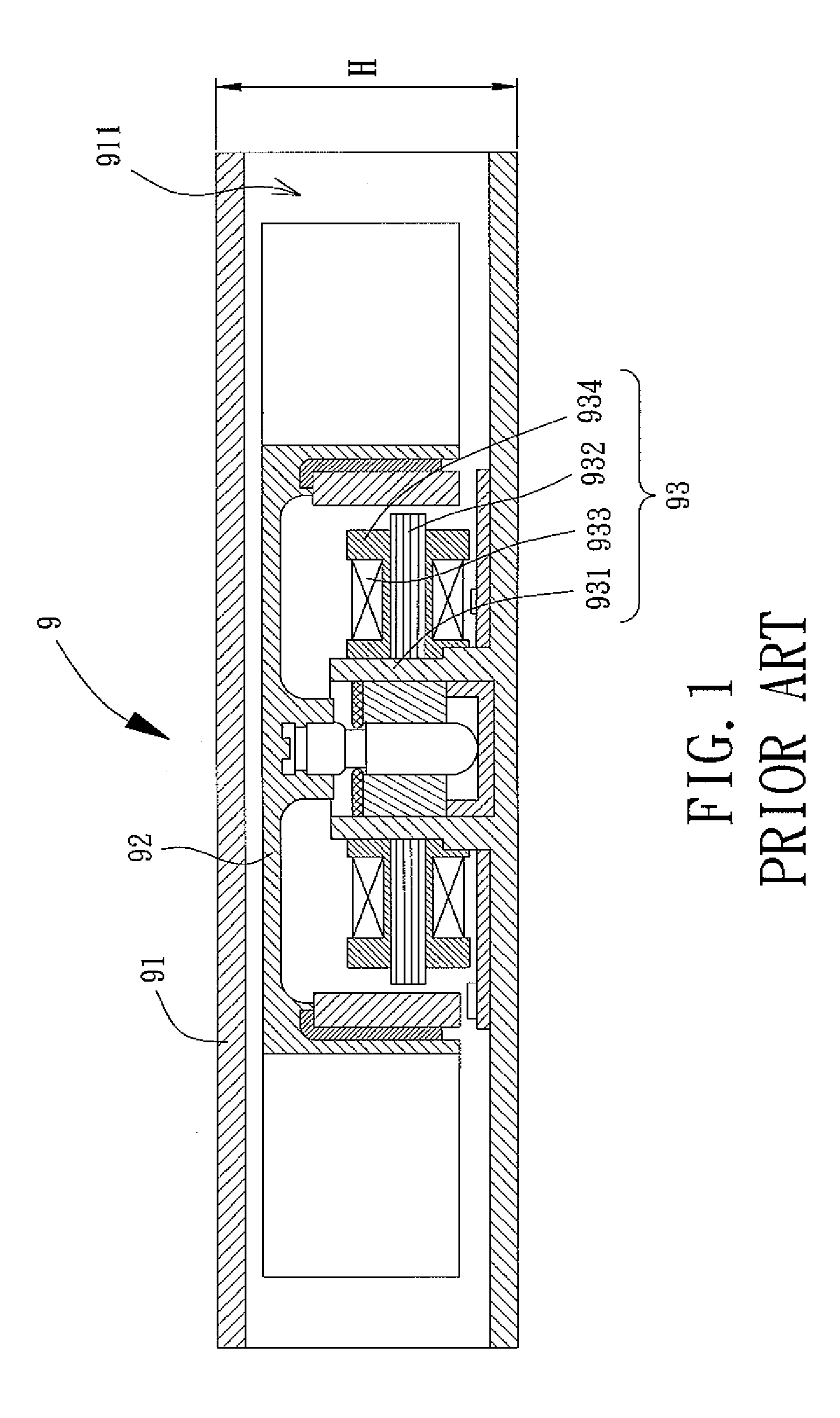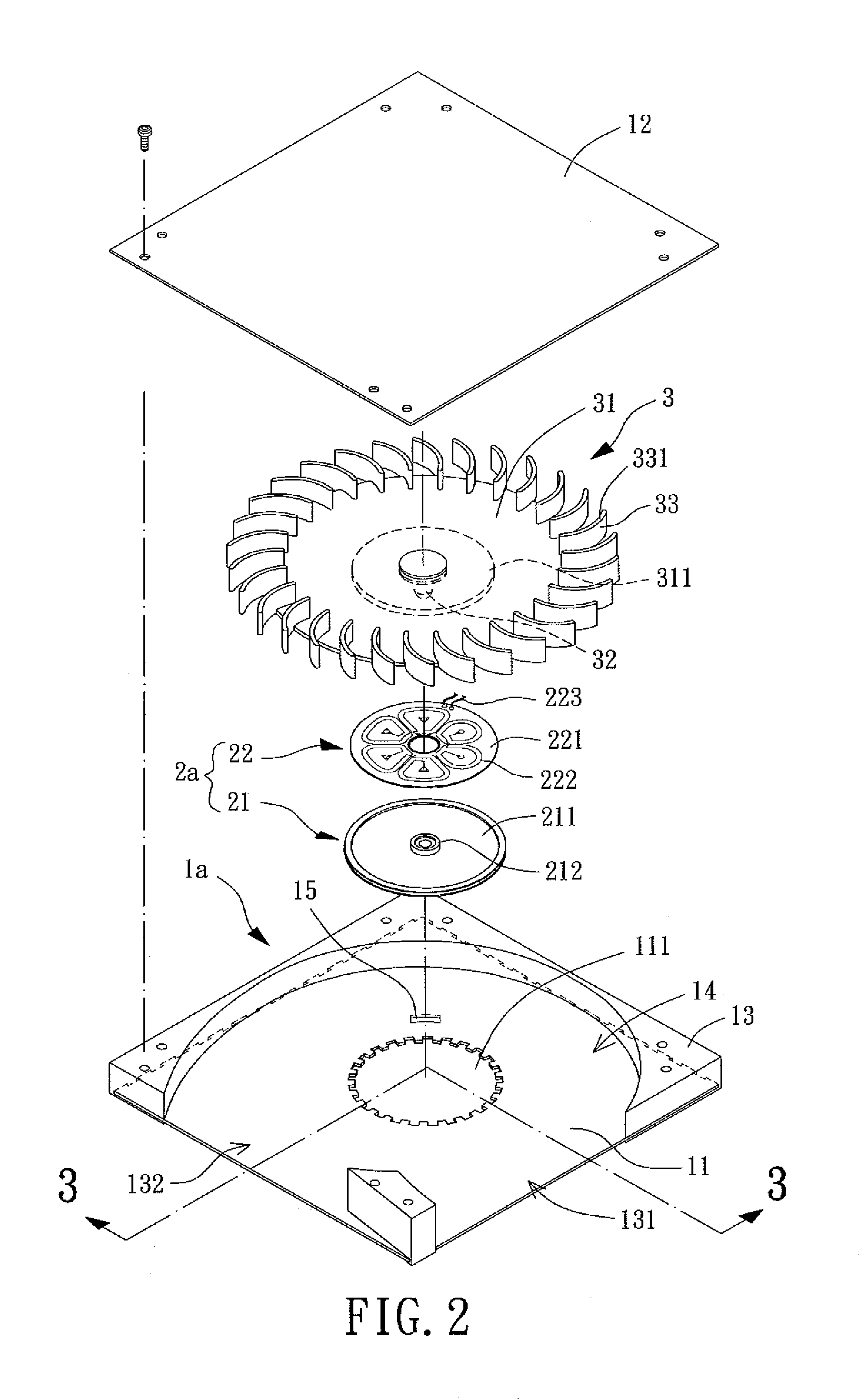Advection fans
a technology of axial fans and air currents, applied in the direction of positive displacement liquid engines, liquid fuel engines, pumping pumps, etc., can solve the problems of not being able to reduce axial fans cannot guide air currents in the radial direction, and the overall axial height of electronic products cannot be reduced. , to achieve the effect of increasing air output and wind pressure, and reducing unnecessary nois
- Summary
- Abstract
- Description
- Claims
- Application Information
AI Technical Summary
Benefits of technology
Problems solved by technology
Method used
Image
Examples
first embodiment
[0041]An advection fan of a first embodiment according to the present invention is shown in FIGS. 2 and 3 and includes a housing 1a, a stator 2a, and an impeller 3. The housing 1a is configured to allow air currents to flow in a radial direction. The stator 2a is mounted to the housing 1a. The impeller 3 is rotatably coupled to the stator 2a and can be driven by the stator 2a to rotate.
[0042]The housing 1a can be any hollow frame that receives the stator 2a and the impeller 3 and that guides air currents in and out in the radial direction. The housing 1a can be of any geometric shape, such as polygonal, cylindrical, or elliptic. In this embodiment, the housing 1a is rectangular in a top view thereof.
[0043]The housing 1a includes a metal housing base 11 and a closure member 12 spaced from the metal housing base 11 in an axial direction. A lateral wall 13 is provided between the metal housing base 11 and the closure member 12 and includes an air inlet 131 and an air outlet 132 spaced ...
second embodiment
[0050]FIGS. 4 and 5 show an advection fan of a second embodiment according to the present invention. Similar to the first embodiment, the second embodiment includes a housing 1b, a stator 2b, and an impeller 3. The housing 1b is substantially the same as the housing 1a and includes a metal housing base 11, a closure member 12, a lateral wall 13, an air inlet 131, an air outlet 132, an air passage 14, and a wire hole 15. The structural features of the housing 1b and the impeller 3 of the second embodiment identical to those of the housing 1a and the impeller 3 will not be described in detail to avoid redundancy.
[0051]The difference between the housing 1b of the second embodiment and the housing 1a of the first embodiment is that the engagement section of the metal housing base 11 of the housing 1b for coupling with the stator 2b (by embedding or abutment / attachment) is in the form of a recess 112 formed in the surface of the metal housing base 11 by punching. The recess 112 includes ...
third embodiment
[0057]FIGS. 9 and 10 show an advection fan of a third embodiment according to the present invention. Similar to the first embodiment, the third embodiment includes a housing 1c, a stator 2c, and an impeller 3. The housing 1c is substantially the same as the housing 1a and includes a metal housing base 11, a closure member 12, a lateral wall 13, an air inlet 131, an air outlet 132, and an air passage 14. The structural features of the housing 1c and the impeller 3 of the third embodiment identical to those of the housing 1a and the impeller 3 will not be described in detail to avoid redundancy.
[0058]The difference between the housing 1c of the third embodiment and the housing 1a of the first embodiment is that the engagement section of the metal housing base 11 of the housing 1c for coupling with the stator 2c by abutment / attachment includes a shaft receiving hole 113 and an engagement face 1131 surrounding the shaft receiving hole 113. Preferably, the engagement face 1131 correspond...
PUM
 Login to View More
Login to View More Abstract
Description
Claims
Application Information
 Login to View More
Login to View More - R&D
- Intellectual Property
- Life Sciences
- Materials
- Tech Scout
- Unparalleled Data Quality
- Higher Quality Content
- 60% Fewer Hallucinations
Browse by: Latest US Patents, China's latest patents, Technical Efficacy Thesaurus, Application Domain, Technology Topic, Popular Technical Reports.
© 2025 PatSnap. All rights reserved.Legal|Privacy policy|Modern Slavery Act Transparency Statement|Sitemap|About US| Contact US: help@patsnap.com



